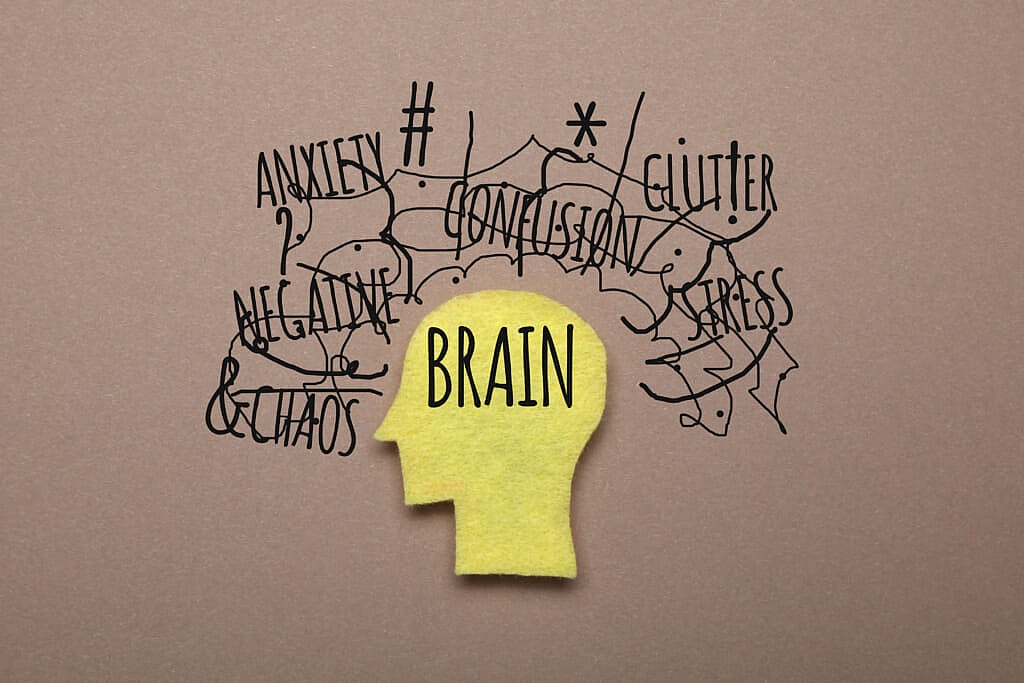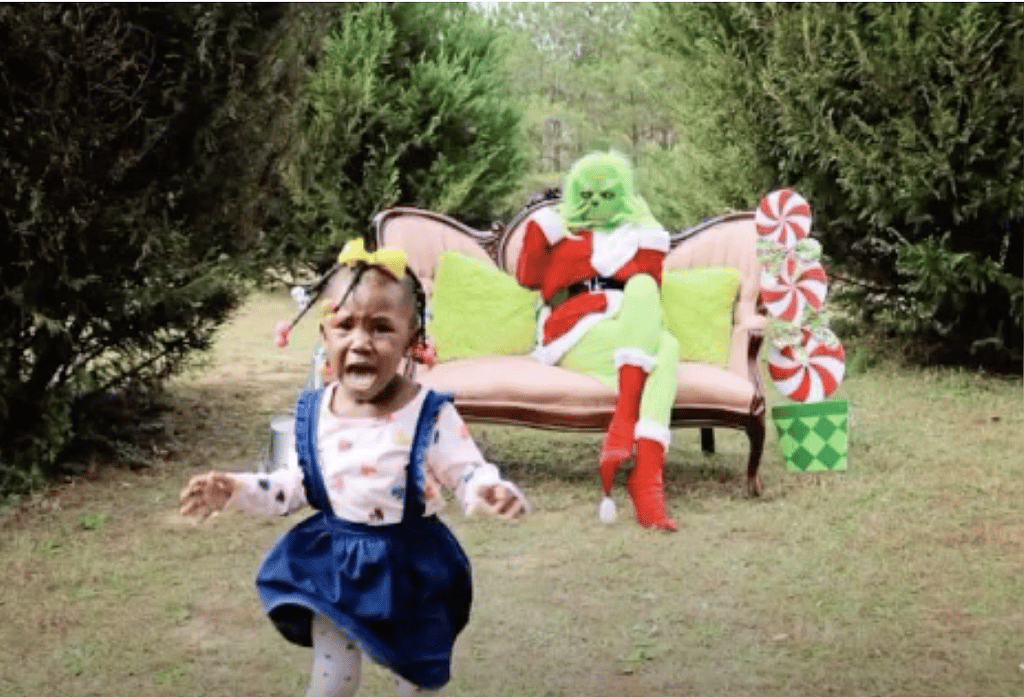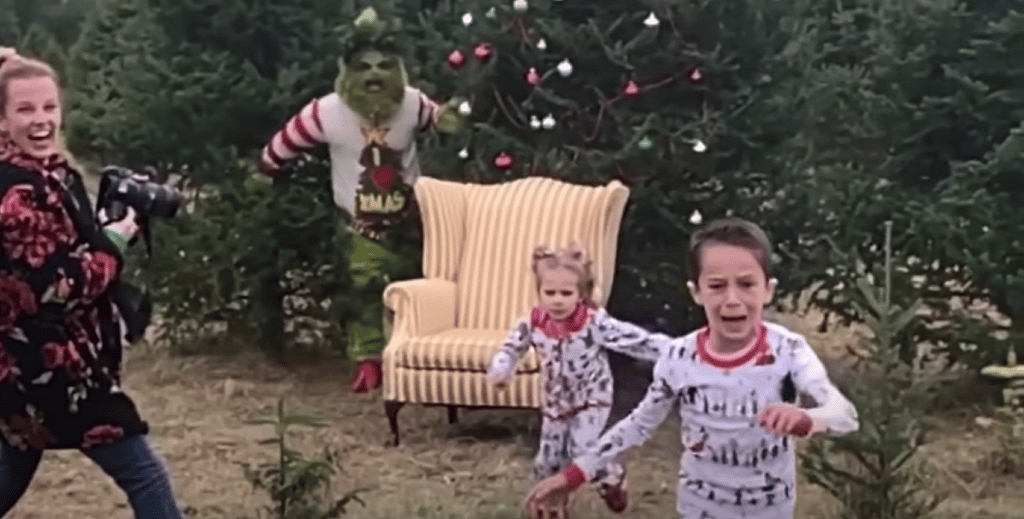Most people associate the Christmas holiday with creating warm, happy moments and memories for their children. But it seems that a growing number of parents are making a holiday tradition out of frightening their kids and then documenting these moments for posterity by sharing them on social media.
“I enjoy scaring children.”
That’s what one Black mother recently wrote on my Facebook page in response to my gripe about dozens of viral photos and videos involving parents who bring their blindly trusting children to Christmas photo shoots where they are frightened and humiliated by Dr. Seuss’s famous ugly hulking Grinch character.
Read More: 50 Georgia children exposed to virus after Santa, Mrs. Claus test positive
These are organized photoshoots with attractive, fancy furnishings plopped into woodsy outdoor settings with Christmas-themed signage. A shoot scheduled for Saturday in St. Louis was sold out. Young children — carefully dressed for holiday pictures — are seen posing on furniture as a Grinch in a Santa suit slowly creeps behind them.
Then the Grinch Santa scares the hell out of them as the photographer captures, frame by frame, the children cringing, crying, screaming, falling, clearly terrified, and often fleeing or trying to move away from the menacing Grinch.
Sometimes these children are white; often they’re Black. What strikes me is how the parents get these kids all dressed up, often in variations of Christmas red and green, and make their children feel safe and comfortable in these serene settings.
Their kids are trusting them completely and have no idea that their parents have collaborated with other strangers to turn a peaceful moment into terror. Some of the children are babies, preverbal and too young to move away from the menacing Grinch.

The Grinch is sometimes played by a white man, Trenton Durham, and other times by a Black woman, Tameka Boyce from Marion, Arkansas, who is seen in some stills holding children upside down by their ankles like a beast that has captured its prey.
You can sometimes see the parents move in close with their own cell phones to snap stills and video clips while laughing uncontrollably as their child reaches out to be rescued.
Boyce posted a video of a girl punching her as she held her crying, screaming sister suspended upside-down in the air. It reminded me of a scene from a slave plantation. One more that’s especially disturbing shows two boys sitting on the couch while a smaller girl runs away. One boy laughs while the other is frozen in fear.
Read More: Jacob Blake’s children so traumatized after shooting they’ll need therapy, family says
These “Grinchmas” photoshoots aren’t new. They first appeared in 2018 when a viral video of a scary Grinch photoshoot made the news. They’ve since spread across the country around holiday time. Some parents have even allowed the Grinch into their homes to scare their children and pretend to steal Christmas gifts.
While parents who participate in the annual trend – and the viewers who laugh along – may think these scenarios are not harmful, the research on brain development provides evidence to suggest otherwise.
Read More: Silence The Shame founder Shanti Das talks trauma, mental health
Let the parents tell it, their children had fun. Sure, they cried for a few minutes, but they quickly conquered their fear and will forget about that moment of terror. There’s no damage here to see. The kids are happy and healthy. It was all great family fun and people like me need to just lighten up and get a sense of humor.
But those of us who study child development and the impact of toxic stress on children’s brains see these moments very differently. Children’s brains are not fully wired to regulate their emotions or to intellectually deconstruct and understand what happened to them and why their parents stood by and took perverse pleasure in their distress.
These scenarios seemed real in their minds. Some of the children in these situations feared they would be harmed or killed. PTSD, panic attacks, anxiety, and phobias are just a few of the negative imprints that get left in a child’s subconscious or unconscious mind as a result of these experiences.

What does it mean when your early experiences of trauma are organized and immortalized by your own mother, who laughs at you and then garners more laughs by sharing it publicly?
Growing children depend on their parents to help them regulate their emotions when they are stressed out by events in their environment. But if a parent is participating in creating unnecessary fear, their children are emotionally abandoned and left to manage their own feelings without support.
A number of parents in these Grinchmas scenes don’t even bother to pick up their crying child to soothe them. They make no effort to protect them. Some ignore their cries, keep on laughing, let their child wander around confused, vulnerable and alone.
The messages these children receive are that they’ve lost their connection to their parents, adults are scary and unreliable, the people you depend on don’t have your back. The people who are supposed to nurture and protect you will create dangerous situations and put you into them for their own entertainment.
This hurt, stress, fear and angst gets embedded in children’s developing neural networks and can impact the way they see themselves and interact with others over their lifespan.
What makes these parents do this to their children?
Let’s talk about what’s wrong with the parents who participate in these Grinchmas photo shoots and all the folks who laugh at them. Why do these adults take such perverse pleasure in terrorizing children?
Moreover, what in the world could ever make any Black parent set their children up for this form of abuse and exploitation in a world where Black children already live in nonstop terror from trigger-happy police, lead poisoning, toxic tap water, endless eco-hazards, neighborhood violence, racist schools, and other socio-economic trappings?
The answer can be found in science. Essentially, something is structurally wrong with the brains of these parents — specifically the regions linked to empathy and compassion. The ventromedial prefrontal cortex is responsible for empathic care for others. When a person experiences stress and anxiety, that area of the brain can be inhibited so that it does not function properly. This means that a parent’s instinct to be loving and protective of their children isn’t working properly.

The parents setting their children up for these attacks find humor in kids being terrorized because their neural networks and cognitive regions that would normally enable them to recognize another person’s fears are compromised. When the right supramarginal gyrus, which is part of the brain region known as the cerebral cortex doesn’t function properly, one’s ability for empathy is dramatically reduced, according to research on the neuroscience of empathy.
These parents (and the laughing audience) cannot distinguish their own emotional state from that of the terrified children because they have a distorted understanding of other people’s emotions. At a neurobiological level, they are incapable of putting themselves in these children’s shoes.
Some of these parents and audiences may actually get a pleasurable “kick” out of viewing their child’s fear. Exposure to media violence, toxic stress, parental neglect and being hit can desensitize us, blunting the brain’s response to second-hand pain witnessed in others.

There are studies of psychopaths that show an increase in an area of the brain called the ventral striatum. This area is known to be involved in pleasure when seeing others in pain. When these particular parents witness their child’s fear, they don’t replicate that state of fear in themselves as if they were in their child’s shoes. Their inability to mentalize the experiences of their child explains why they don’t take steps to intervene as a protector or to soothe their child.
But why are they going out of their way to set up — and pay for — their children to be mentally and psychologically traumatized in this manner?
The parents have to have some unhealed wounds that cause this behavior. The areas of their brain and nervous system that would help them be attuned and connected to children are shut down. When it comes to Black children, so much of the culture tells us to view and parent them in a detached, non-empathic way in which they are seen but not heard, speaking only when spoken to.
There’s a cultural belief that Black children need fear, coercion, beatings, and toxic pedagogy to learn, to be kept safe from police and racism. Somehow scaring them will ultimately immunize them against death and ensure their future survival.
This harkens back to enslavement when children were property and could be brutalized or sold away from their parents, their families, without notice. The history of Blackness in this country underscores and supports this form of detached parenting.
Re-enacting Trauma
A healthy parent would never intentionally terrorize their child. These parents who arrange these photoshoots, and the audiences that find them funny have unhealed wounds. They are walking around disembodied from themselves, which can contribute to weak and non-nurturing attachments to their children. Something or someone has shut down the parents’ systems that would otherwise help them be attuned and connected to their own children.
Intentionally scaring children is a way of reenacting scenes and past traumas from their own childhood as a way to master them. It’s often subconscious and a defensive strategy. They’re actually addicted to trauma, even if they don’t remember what caused that trauma in the first place.
They repeat the repressed events through their children. Then the pattern is passed down so that youngsters who have been traumatized are inextricably drawn into situations that replicate the original trauma. They are likely to feel the urge to resolve those past traumas through reenactment.
When those children grow up and have their own children, there is a good chance they can end up doing something like staging a holiday media situation to terrorize their own children, and then share it for laughs. This form of repeating the past and exposing young children to any form of terror is an expression of the parents’ and viewers’ inability to move beyond their own traumatic experience.

They think that if they make a joke out of it, they can remove themselves from the pain and it’ll all feel OK. The joking provides a false sense of safety. It creates a twisted cycle where terrorizing, shaming, humiliating and laughing at children’s distress is a way for these parents to feel relief in their own nervous systems.
It shows that they are disconnected from their own bodies and the parts of their brains that enable them to feel the kind of parental love and empathy that would motivate them to nurture their children and protect them from danger. The parent-child bond might never have formed and even if it did, incidents like these horrible holiday photo ops cause even greater damage.
I’m sure that many or even most of these parents tell themselves that they engage in these acts out of love. This narrative makes them feel safe, keeps them from feeling overwhelmed by guilt about harming their children. Their brains and nervous systems are stuck in survival mode — they always feel unsafe in the world and hyperalert, and they project this onto their children.
A parent who allows their child to be terrorized in this manner is operating from a subconscious place. They aren’t aware that their own bodies have created genetic patterns that are transferred to future generations. The fact that they are creating and laughing at their children’s terror is a trauma response from their own significant childhood wounds.
The Racial Dynamic
The trauma of enslavement is encoded in the DNA of Black people and has been passed down through each generation, impacting genetics, psychology, emotional development, and behaviors. It becomes part of the African American genome, reenacted unconsciously. Many of our people might not be able to access a nurturing, feel-good sense of safety and belonging that comes with healthy parenting.
White parents who organize these photo and video shoots are propelled by a different dynamic. Terrorizing children and creating trauma is part of their cultural heritage and a core feature of whiteness. European mythology, fairy tales, nursery rhymes and art are replete with these themes.

Terrorizing and emotionally destroying children as a form of social control is a core feature of white supremacist culture. It’s no coincidence that we see these scenes most often at Christmas time, a 2,000-year-old white Christian tradition that is racist and violent to the core.
Think about how children are treated in the Bible. Babies are drowned. God sends bears to eat children for laughing at a bald man. Abraham almost sacrifices his son Isaac. God sent his only son to be tortured and lynched on a cross. Krampus is a demon that punishes and terrorizes misbehaving kids around the holiday. Witches eat misbehaving children. In fairytales, kids are eaten, murdered, chopped up and sexually abused.
Like the parents who smash cakes in children’s faces, throw cheese at them, “accidentally” throw water in their faces, punch stuffed animals to get them to eat, cut their hair as punishment, and engage other forms of digital shaming, the parents who set their kids up for holiday trauma in front of a camera are not only acting out their own unresolved issues, they are upholding white supremacist child abuse, even if they’re not consciously aware of what they’re doing.
Children deserve dignity and privacy and should be protected from this form of cyberbullying. I think it is time for states to consider and pass legislation to issue fines against adults who post child terror porn.
Moreover, all the slave masters from the past must be rolling over in their graves from laughing at all the Black folks who’ve turned scaring their own children into a monetized holiday tradition.
There’s nothing amusing about Black child fear and trauma. Let’s decolonize our parenting and purge out culture of these bizarre white supremacist traditions that depend on us damaging our own children and calling it either love, protection or humor.

Stacey Patton, PhD is the author of Spare The Kids: Why Whupping Children Won’t Save Black America and the forthcoming book Strung Up: The Lynching of Black Children in Jim Crow America.
Have you subscribed to theGrio’s podcast “Dear Culture”? Download our newest episodes now!
TheGrio is now on Apple TV, Amazon Fire, and Roku. Download theGrio today!


